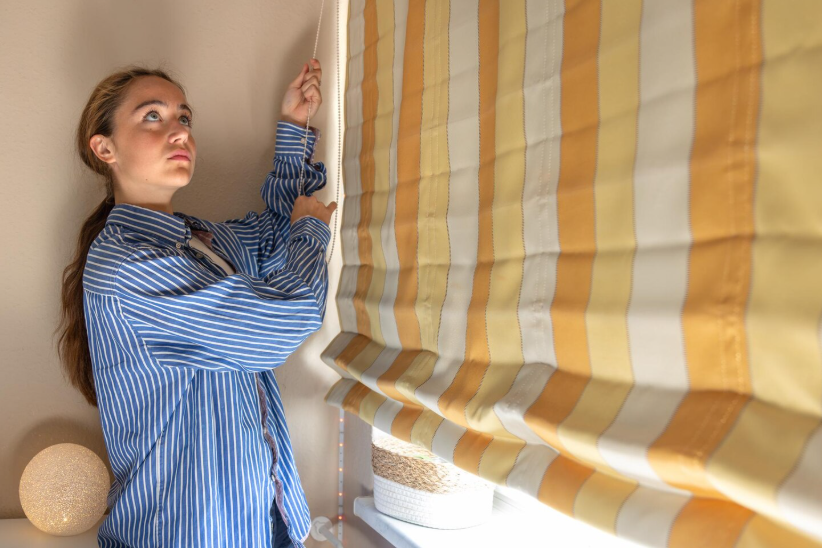Transform your space with personalized Roman shades that bring both function and beauty to any room. Whether you’re refreshing your living room windows or working on a project similar to custom window installation in New York, creating your own Roman shades allows you to control every detail from fabric choice to final embellishments. Begin by selecting durable fabrics like linen or cotton that complement your decor. Accurately measure your window frame, adding extra for hems. Sew with precision, ensuring straight lines and strong stitches.
Attach rings evenly for smooth functionality. Secure cords with a cleat for easy adjustments. Add a touch of elegance with a trim that matches your style. This guide will help you master each step in creating custom Roman shades for a stunning home transformation.
Fabric Selection
When selecting fabric for our Roman shades, we aim for a balance of durability, texture, and color that will effortlessly enhance our home decor. The fabric needs to withstand daily use while adding a touch of elegance to our living space. Opting for materials like linen, cotton, or polyester combinations can ensure both longevity and style.
We look for textures that bring depth and interest, such as subtle weaves or delicate patterns that catch the light just right. Choosing colors that complement our existing interior design scheme is necessary; whether we go for neutrals to create a timeless look or bold hues to make a statement, the fabric sets the tone for the entire room.
Measurement and Cutting
In preparing to create Roman shades, we begin the process of precise measurement and cutting to guarantee a custom fit for our windows. Start by measuring the width of your window frame for the shade’s width, adding extra fabric for hems and folds.
Next, measure the length from the top of the frame to where you want the shade to fall, including allowances for hems. When cutting the fabric, ensure straight lines by using a rotary cutter and a cutting mat. Accuracy is vital to achieve a professional look.
Take your time to measure twice and cut once. Double-check your measurements before making any cuts to avoid costly mistakes. With careful measurement and precise cutting, your Roman shades will fit perfectly and elevate the style of your home.
Sewing Techniques
Now we’ll focus on the sewing techniques that will bring life to your Roman shades with finesse and elegance. To start, make sure your machine is threaded with a matching color for a seamless finish.
Begin by hemming the sides and bottom of the fabric, using a straight stitch for a clean edge. Next, create pockets at the top for the rods by folding and stitching a channel.
When attaching the rings for the cords, strengthen the stitching for durability. For a professional touch, consider adding decorative elements like fabric tape along the edges. Precision is key in sewing Roman shades that exude sophistication and charm.
Rod Pocket and Rings
With precision and finesse, we carefully craft the rod pockets and attach the rings to guarantee the functionality and elegance of our Roman shades. The rod pocket serves as a casing for the rod to slide through, ensuring smooth operation, while the rings provide a decorative touch and help the fabric fold neatly when the shade is raised.
When working on the rod pocket, measure accurately to ensure a perfect fit for the rod. Maintain consistent spacing between rings for a balanced appearance. Use strong stitches to attach the rings securely to the fabric, and choose durable rings that complement your chosen material. Test the movement of the shade to make sure it raises and lowers effortlessly before moving on to the final installation steps.
Cord and Cleat Installation
Guiding the cord through the rings and securing it with a cleat completes the functional aspect of our Roman shades. The cord, a vital component, allows for smooth operation and adjustment of the shades. To begin, thread the cord through each ring along the back of the shade, ensuring it runs smoothly without any twists or tangles.
Once all rings are threaded, bring the cord down to the cleat, a small but necessary piece that will hold the excess cord securely in place. Wrap the cord around the cleat in a figure-eight pattern, creating a neat and organized look while also ensuring easy access for adjusting the shade’s height. This step not only enhances the functionality but also adds a professional touch to your homemade Roman shades.
Finishing Touches
For a final flourish on your Roman shades, consider adding decorative trim to the bottom edge for a touch of elegance and personality. This simple addition can elevate the overall look of your shades and tie the room’s decor together seamlessly. To ensure your finishing touches are executed flawlessly, select a trim that complements the fabric and style of your Roman shades. Measure the bottom edge accurately to determine the amount of trim needed.
Use fabric glue or a sewing machine to firmly attach the trim to the shades, making sure the trim is evenly spaced along the bottom edge for a polished finish. Conduct a thorough inspection to make sure the trim is securely attached and visually appealing. These final details will transform your handmade Roman shades from simple window coverings into custom pieces that reflect your personal style and craftsmanship.
Related Topics:
- Understanding What Are Solar Shades and Their Benefits
- A Beginner’s Guide on How to Measure for Roman Shades


Recent Comments